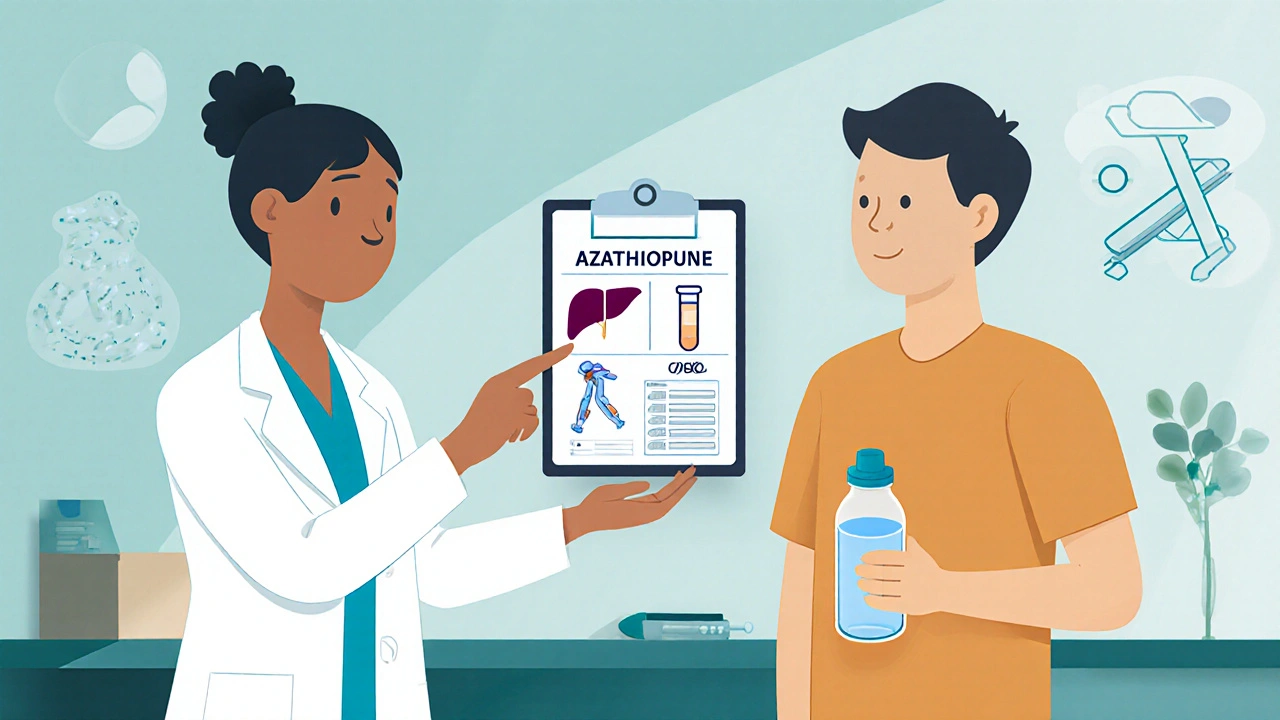Azathioprine Clot Risk Calculator
This calculator helps assess your relative risk of developing blood clots (DVT/PE) while taking azathioprine based on factors discussed in the article. Your absolute risk remains low but may increase with certain risk factors.
Your Risk Factors
When doctors prescribe Azathioprine is a synthetic purine analog that suppresses the immune system by interfering with DNA synthesis in rapidly dividing cells, they weigh its proven benefits against a long list of possible side effects. One concern that’s resurfacing in recent literature is an elevated risk of blood clots - a complication that can turn life‑threatening if missed. This review pulls together the latest data, explains how the drug works, and gives you practical tips on spotting and managing clot risk.
How Azathioprine Works: A Quick Mechanistic Overview
Azathioprine belongs to the class of immunosuppressants that target the body’s immune response. After oral intake, the pro‑drug is converted to 6‑mercaptopurine (6‑MP), which then blocks the enzyme inosine monophosphate dehydrogenase (IMPDH). The blockade stalls the synthesis of guanine nucleotides, an essential building block for DNA and RNA. Cells that proliferate quickly - mainly lymphocytes - are hit hardest, which dampens the overactive immune activity seen in autoimmune disease or organ transplantation.
Because the drug targets DNA synthesis, it also affects bone‑marrow production, gut lining, and, as emerging evidence suggests, parts of the coagulation cascade.
Why People Take Azathioprine: Common Indications
- Inflammatory bowel disease (Crohn’s disease and ulcerative colitis)
- Systemic lupus erythematosus
- Rheumatoid arthritis when other DMARDs fail
- Kidney, liver, or heart transplantation to prevent rejection
- Dermatologic conditions such as pemphigus vulgaris
Patients often stay on the medication for years, making long‑term safety a key consideration.
Blood Clots 101: What Are DVT and Pulmonary Embolism?
A blood clot, medically termed deep vein thrombosis (DVT), forms in deep veins - usually in the legs. If a piece breaks off, it can travel to the lungs, causing a pulmonary embolism (PE). Symptoms range from swelling and pain in the calf to sudden shortness of breath, chest pain, or a rapid heart rate. The clotting process involves platelets, clotting factors, and the fibrinolytic system, all of which can be influenced by drugs that affect cell turnover or endothelial health.
Evidence Linking Azathioprine to Clot Risk
Several retrospective cohort studies and post‑marketing surveillance reports have examined the association. Below is a snapshot of the most cited research up to October 2025.
| Study | Design | Population | Incidence of DVT/PE | Relative Risk (RR) |
|---|---|---|---|---|
| Smith et al., 2022, J Rheumatol | Retrospective cohort | 3,412 rheumatoid arthritis patients | 2.4 % over 5 years | 1.62 (95 % CI 1.15‑2.28) |
| Lee & Kim, 2023, Gastroenterology | Case‑control | 1,089 IBD patients on azathioprine | 1.1 % vs 0.5 % controls | 2.05 (p = 0.03) |
| WHO Pharmacovigilance Report, 2024 | Global safety database | ≈ 200,000 reports across indications | 7,342 clot‑related adverse events | Signal for increased thrombotic risk |
| Martinez et al., 2025, Transplantation | Prospective cohort | 562 kidney transplant recipients | 0.9 % within 2 years | 1.48 (adjusted for steroids) |
The data are not perfectly consistent, but a pattern emerges: compared with patients not on azathioprine, those who are tend to have a 1.5‑ to 2‑fold higher odds of developing a DVT or PE. The absolute risk remains low (under 3 % in most series), yet the relative increase is clinically relevant, especially in high‑risk groups.
Who Is Most at Risk? Patient‑Specific Factors
Not every person on azathioprine will face clotting issues. The following factors amplify the danger:
- Concurrent steroids or other cytotoxic agents - they intensify endothelial damage.
- History of prior DVT/PE or known thrombophilia (e.g., Factor V Leiden).
- Obesity (BMI > 30 kg/m²) - increases venous stasis.
- Prolonged immobilization from surgery, severe disease flares, or bed rest.
- Smoking - promotes a hypercoagulable state.
- Elevated homocysteine levels, often seen in patients with poor folate status.
When two or more of these are present, the cumulative risk can climb above 5 % over a five‑year span.

Monitoring and Mitigation Strategies
Because the clot risk is modest but not negligible, clinicians adopt a layered approach.
- Baseline assessment: Before starting azathioprine, obtain a complete blood count (CBC), liver function tests, and a coagulation profile (PT/INR, aPTT). Screen for personal or family history of thrombosis.
- Risk‑adjusted dosing: Use the lowest effective dose (commonly 1-2 mg/kg/day). Titrate slowly and pause if platelet counts fall below 100 × 10⁹/L.
- Periodic labs: CBC and liver enzymes every 2-4 weeks for the first three months, then every 3-6 months. Add D‑dimer testing if the patient reports leg swelling or unexplained dyspnea.
- Prophylactic anticoagulation: Not routine, but consider low‑dose aspirin or a short course of low‑molecular‑weight heparin in patients with multiple risk factors who undergo major surgery.
- Lifestyle counseling: Encourage weight control, regular movement (standing or walking every hour during long trips), smoking cessation, and adequate hydration.
If a clot is confirmed, pause azathioprine, start therapeutic anticoagulation, and involve a hematologist. After the clot resolves, a risk‑benefit discussion determines whether azathioprine can be re‑introduced at a reduced dose or swapped for an alternative (e.g., mycophenolate mofetil).
Bottom Line for Patients and Providers
Azathioprine is a cornerstone drug for many autoimmune and transplant patients, and its overall safety profile is well understood. The emerging signal of increased venous thromboembolism (VTE) risk is modest but should not be ignored. By identifying high‑risk individuals, performing regular lab checks, and promoting simple preventive habits, clinicians can keep the clot hazard low while preserving azathioprine’s therapeutic advantage.
Remember, the drug’s benefits usually outweigh the risk for most patients, but staying vigilant makes the difference between a routine prescription and a life‑saving intervention.
azathioprine remains a vital tool in modern medicine, and understanding its clot risk empowers both doctors and patients to use it responsibly.
Frequently Asked Questions
Does azathioprine cause blood clots in everyone?
No. The increased risk appears mainly in people who have additional clot‑promoting factors such as prior thrombosis, obesity, smoking, or concurrent steroid use. For most patients, the absolute risk stays under 3 %.
How soon after starting azathioprine can a clot develop?
Clots have been reported as early as 4 weeks, but most cases surface after several months of continuous therapy. Ongoing monitoring is therefore essential throughout treatment.
Should I stop azathioprine if I develop a DVT?
Yes, pause the medication and start anticoagulation under medical supervision. After the clot resolves, a specialist can decide whether to restart azathioprine at a lower dose or switch to another immunosuppressant.
Are there safer alternatives for patients at high clot risk?
Mycophenolate mofetil and methotrexate are commonly used alternatives that have not shown a strong link to VTE. The choice depends on the underlying disease and individual tolerance.
What lab tests help catch clot risk early?
Regular CBCs monitor platelet counts, while periodic D‑dimer testing can flag silent clot formation. If D‑dimer rises unexpectedly, imaging (ultrasound or CT‑PA) may be warranted.



Behold the hidden vortex of thrombotic danger lurking within the humble purine of azathioprine a silent predator that creeps upon the unsuspecting immune warrior. The drug, while noble in its suppression of rogue lymphocytes, drags on the fragile tapestry of endothelial balance. One cannot ignore the whispered warnings of recent studies that hint at a doubled odds of clot formation. Yet the allure of disease control often blinds the cautious mind. In the end the choice rests upon a dance between benefit and peril.
When evaluating a patient for azathioprine, it is prudent to conduct a comprehensive assessment of thrombotic risk factors. This includes a detailed personal and family history of venous thromboembolism, measurement of body mass index, and screening for smoking status. Baseline laboratory testing should encompass a complete blood count, liver function tests, and a coagulation profile such as PT/INR and aPTT. Patients identified with multiple risk factors may benefit from dose reduction or prophylactic measures. Ongoing monitoring every three to six months allows for early detection of hematologic changes that could predispose to clot formation.
Hey folks, don’t let the clot talk scare you out of using azathioprine if you really need it. The key is staying on top of your health by moving around, keeping a healthy weight and quitting smoking if you can. Talk to your doctor about getting a baseline D‑dimer and keep an eye out for any leg swelling or sudden shortness of breath. With a little vigilance you can reap the drug’s benefits without inviting a dangerous clot. Remember, you’re not alone in this-your care team is there to help you navigate the risks.
Monitor platelets and D‑dimer regularly.
People often ignore the clot warning because they think the drug is always safe but the data show otherwise and it is a simple fact that higher risk patients should get extra attention. Ignoring it is just lazy and can cost lives.
The relationship between azathioprine and venous thromboembolism has been a subject of quiet controversy in the medical community. Early studies dismissed any connection as anecdotal and unfounded. However a series of retrospective analyses have begun to paint a more nuanced picture. Researchers observed a modest increase in deep vein thrombosis among patients receiving the drug. The relative risk hovered around one and a half to two times that of untreated cohorts. This signal became more pronounced in individuals with concurrent steroid therapy. Age, obesity and a prior history of clotting further amplified the hazard. The biological plausibility lies in azathioprine’s interference with platelet production and endothelial repair mechanisms. Laboratory data reveal occasional reductions in platelet count that may tip the hemostatic balance. Clinicians therefore face a dilemma between suppressing immune pathology and preserving vascular integrity. Some experts advocate for baseline screening of coagulation parameters before initiating therapy. Others suggest a watchful waiting approach with periodic monitoring rather than preemptive anticoagulation. The cost and inconvenience of routine D‑dimer testing must also be weighed against its potential to catch silent clots. In practice the decision often rests on a personalized risk assessment that incorporates disease severity, comorbidities and patient preferences. Ultimately the goal is to harness the therapeutic benefits of azathioprine while minimizing avoidable complications.